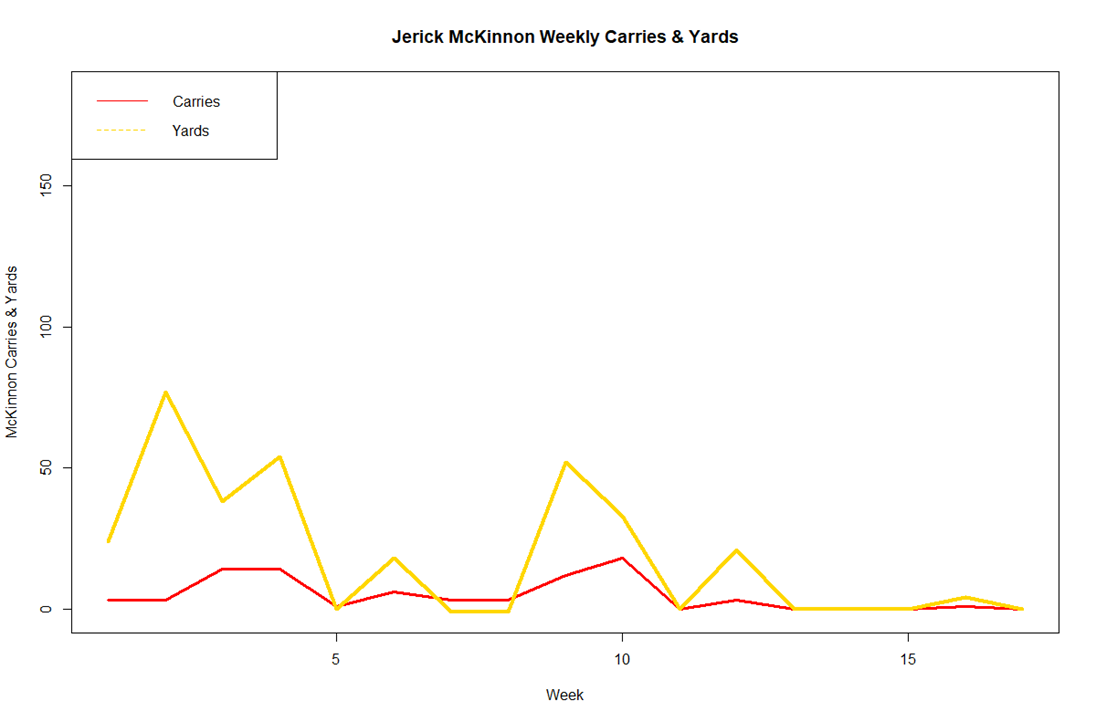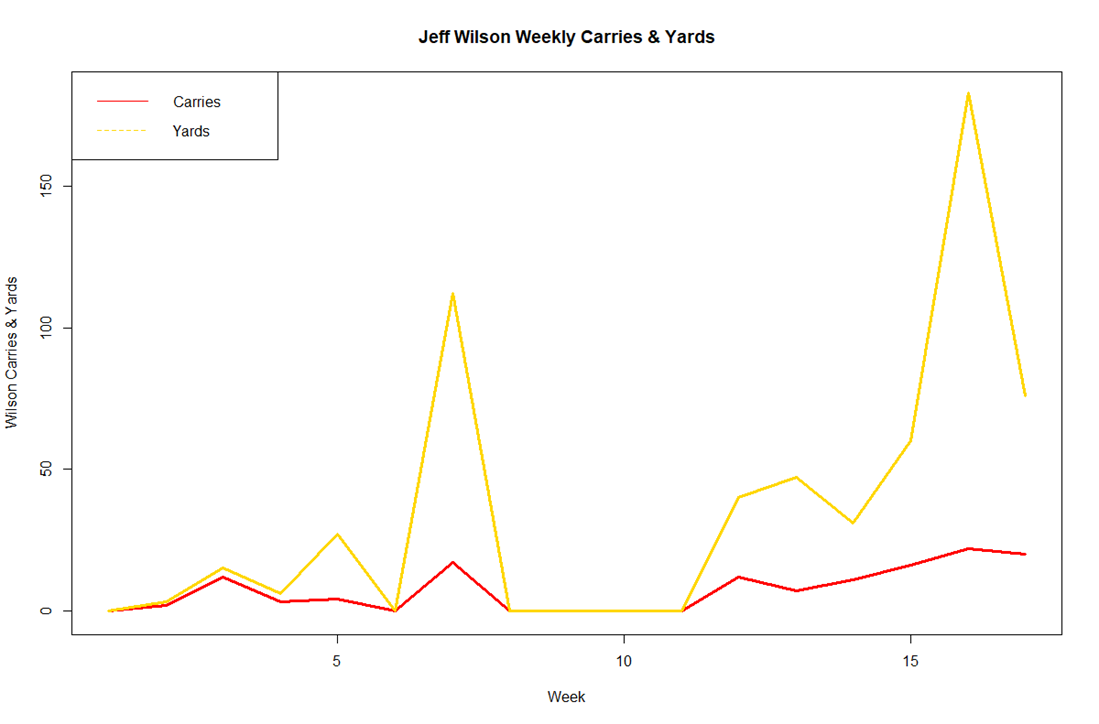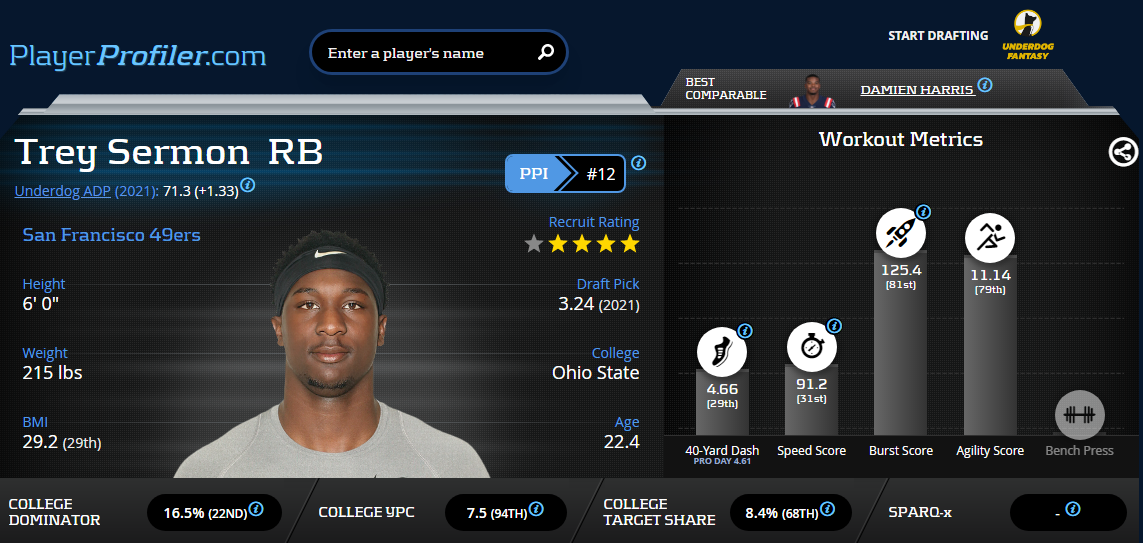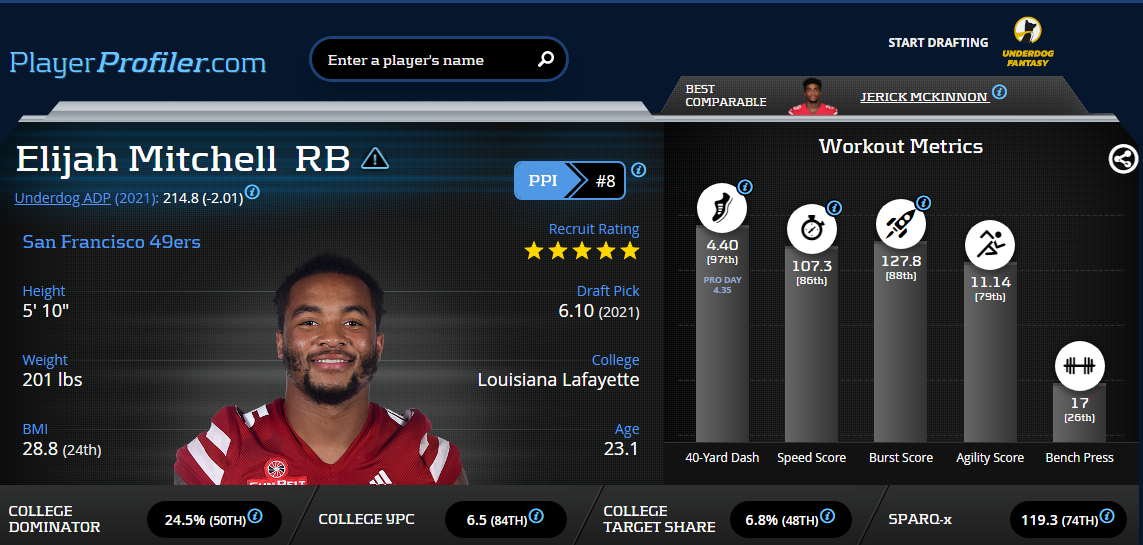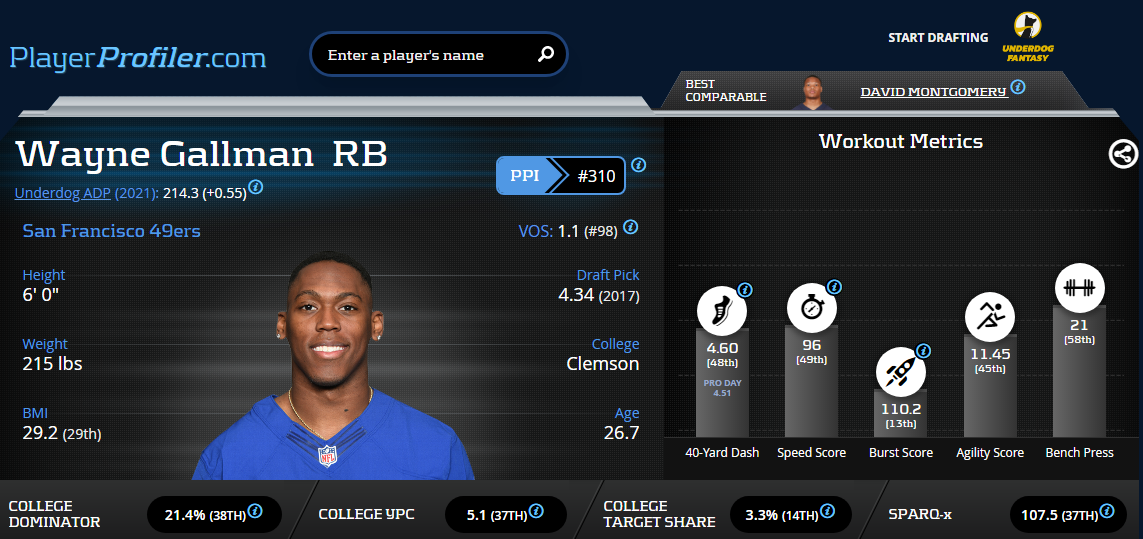Running back is the most polarizing position in fantasy football. From LaDainian Tomlinson and Brian Westbrook to Todd Gurley and Christian McCaffrey, fantasy players claw for top-tier backs. However, in an age where RB seems to become less and less valuable, fantasy players must find which young guys or veterans on one-year deals can boom at any given moment.
There are a few backfields in the NFL employing a near unpredictable “running back by committee” every week. The San Francisco 49ers are one of them. The root of frustration for fantasy players, Kyle Shanahan’s offense has produced several fantasy relevant running backs in recent years. However, none of these guys have been definite “RB1s” for fantasy in San Francisco’s run heavy offense. So, how exactly should fantasy players look at this backfield?
Recent Usage Breakdown
When thinking of the best 49ers running back of the past few years, Raheem Mostert comes to mind.
In 2019 and 2020, Mostert combined for 1,293 rush yards, taking over the so-called lead role in the 49ers backfield. However, he only appeared in 23 out of a possible 32 games in that time span, his usage varying game to game. In that time, he never received 14 or more carries in more than two straight games, catching three or more passes in only three. Mostert also did not receive an Opportunity Share or Weighted Opportunities above the No. 37 mark among qualified running backs in either of the last two seasons.
While Mostert has looked like the best RB in San Francisco over the last few years, he did not receive enough opportunity to become a fantasy RB1, while injuries also hindered him.
Past Mostert, RB opportunities were spread out. Jerick McKinnon received the highest Target Share (9.8-percent) among the backs over the past few years, but missed all of 2018 and 2019 to injury, never consistently getting into the backfield rotation until last season. No other San Fran RBs were given a definite Nyheim Hines-type role in the backfield, with all non-McKinnon backs seeing a Target Share below 7.5-percent over the past few years. Having shallow targets George Kittle, Deebo Samuel, and Kyle Juszczyk (fullback for our purposes here) mixed with a rotation of quarterbacks the last few seasons hasn’t helped the backfield with receiving usage either.
In 2020, McKinnon and Jeff Wilson were the two top RBs for the 49ers when combining opportunity and production. Wilson had the highest Fantasy Points Per Game average and Snap Share, but also played an offensive snap in only 11 games. While Wilson was an effective physical runner, he did not see enough pass-catching opportunity out of the backfield. McKinnon had the most Weighted Opportunities and highest Target Share, seeing touches in 14 games.
49ers backfield usage week 8:
snaps:
mckinnon: 33
hasty: 27
coleman: 7routes:
mckinnon: 22
hasty: 14
coleman: 3touches:
mckinnon: 7
hasty: 13
coleman: 3fantasy pts:
mckinnon: 13.9
hasty: 10.1
coleman: 2.0— the podfather™️ (@Fantasy_Mansion) November 2, 2020
Seeing McKinnon’s prevalence for the 49ers offense amidst injuries is important because it shows that there is a place of relevance for a pass-catching running back in San Francisco. While Mostert and Wilson were efficient with their targets, they did not receive enough to be top fantasy RBs.
A physical runner and learned pass-catcher with Kyle Shanahan and Trey Lance’s trust is the key to unlocking an RB1 from the San Fran backfield.
Does “The Hot Hand” Matter?
Does Kyle Shanahan like to ride “the hot hand?” By this, I ask if a running back was highly productive with his carries one week, will he see increased carries the next week? Seeing if this “hot hand” behavior occurs often can help predict and target a running back in line for increased usage week by week.
There were two San Francisco RBs receiving offensive snaps in 11 or more games last season who I graphed carries and rush yardage by week for (via PlayerProfiler game logs):
Jerick McKinnon’s early season yardage was high, resulting in a carry increase for Weeks 3 and 4. However, his carries then fell off with his production decrease and he was not fantasy relevant until Week 8, which led to a carry increase in Weeks 9 and 10.
More interesting (to me, at least) RB stats from the Data Analysis tool over at @rotounderworld – RBs with the highest rate of stuffed runs
Jerick McKinnon (25.9%) – 21 runs
Phillip Lindsay (24.6%) – 29
Tony Pollard (23.8%) – 24
Nyheim Hines (23.6%) – 21
Benny Snell (22.5%) – 25— Neil Dutton (@ndutton13) February 26, 2021
Jeff Wilson, on the other hand, came onto the scene after injuries to the 49ers offense. He had a huge Week 7 with lots of yardage and touches, then missed several games due to injury. He was productive upon his return, seeing a general increase in carries at the end of the season as a result of his productivity and Raheem Mostert’s injury. Wilson and McKinnon’s graphs can tell us that Kyle Shanahan does like to ride the hot hand of any RB that is productive, as he should. This is also seen from Mostert’s rise to prominence in 2019.
However, a back can easily fall out of favor with Shanahan, evidenced by McKinnon’s several dud performances in 2020. While injuries impacted the 49ers backfield, we can still see that if a San Fran RB is having a particularly effective game, he is more likely to see increased opportunity in that game, as well as next week’s game. Injuries and inefficiency are more likely to lead to decreased touches. There is less of a “bell cow” approach here, where no matter how an RB performs one week, their touches will expect to stay the same the next (examples include Derrick Henry and Ezekiel Elliott).
2021 Backfield Breakdown
The prominent San Francisco running backs to look at for fantasy are Raheem Mostert, Wayne Gallman, Jeff Wilson, JaMycal Hasty, Trey Sermon, and Elijah Mitchell. Out of these, Wilson is hurt for beginning of season, while Sermon and Mitchell are rookies. Mostert and Gallman are veterans who have been effective before and are bound to get touches, while Hasty will likely only see touches on account of a large number of injuries.
We already discussed Mostert earlier, highlighting that he was the best 49ers RB over the past few seasons. Injuries greatly hampered his production, but he still looks to enter 2021 as the first option on the depth chart. He has been an excellent runner, but his usage in the passing game has been low, recording Route Participation rates of 31.7-percent in 2020 and only 19.5-percent in 2019. Due to his injury history and age (29), Mostert is a better option in redraft than dynasty leagues. His current Underdog ADP lands around the end of the seventh round; anything past that would make for excellent value for best ball and redraft leagues.
Rookies Trey Sermon and Elijah Mitchell both have ample dynasty value.
Sermon has the advantage in draft capital and provided excellent production at a top-tier college program, averaging 7.5 (94th-percentile) yards per carry in 2020.
Sermon has a larger physical profile than Mostert and Mitchell, standing at 6-0, 215-pounds, with upper-percentile Burst and Agility Scores. His speed workout metrics were on the lower side, and while he did have an 8.4-percent (68th-percentile) College Target Share, which would rank best among current 49er RB Target Shares, he did not draw more than 20 targets in a college season. In a crowded backfield, he won’t get 15-20 touches per game immediately, but can become the hot hand quickly, increasing his role in the process.
Sermon is 22, imposing, and productive. With Mostert, Wilson, and Gallman headed for 2022 free agency, he is the best 49ers RB for dynasty. He is currently going a few spots ahead of Mostert on Underdog. This should continue, given his youth and Mostert’s battered injury history.
https://youtu.be/DnL07zyj79U
Mitchell is a good fit in the San Francisco offense. While he has a smaller profile than Sermon, he has better speed and athleticism.
Mitchell was a productive college runner with a 6.5 (84th-percentile) yards per carry average and – oh! Lo and behold, his Best Comparable Player is Jerick McKinnon, San Fran’s RB1 in Weighted Opportunities in 2020. Mitchell has similar size and speed to McKinnon, and he was an effective runner in college. He’s got the intangibles to be a versatile weapon out of the backfield; a rich man’s 2020 McKinnon. If he can learn to be an effective pass-catcher, he would make a run for an RB1 spot. However, depth chart and draft capital are working against him, so he won’t be as relevant immediately, barring injuries. He provides late round dynasty value as a player who could gain Shanahan’s trust soon.
kyle shanahan is less susceptible to rb size bias than other nfl coaches, and elijah mitchell sure looks like the next raheem mostert. https://t.co/r7Qw5As0Pw
— the podfather™️ (@Fantasy_Mansion) May 21, 2021
Beware of Wayne Gallman
I can hear readers’ eyebrows raising as I write this, but I am writing this section regardless. Wayne Gallman’s impact will be in redraft leagues as a player who can emerge on any given day for the 49ers.
Last season for the Giants, Gallman had:
- 9.8 (No. 35) Fantasy Points Per Game
- 130.6 (No. 33) Weighted Opportunities on a team that averaged 24.9 (No. 26) Team Run Plays Per Game
- 26.2-percent (No. 15) Juke Rate
- 7 (No. 18) Breakaway Runs
Gallman received opportunities at an RB3 rate, with an increased role after Saquon Barkley’s injury. His efficiency was middling, but was not any lower than what was displayed by the San Fran backs. He was productive on a team with a less run-heavy offense. With a similar physical build to Trey Sermon, he brings more experience to the backfield. Monitor Gallman as a late pick in redraft leagues. He could suck carries away from your favorite rookie 49ers RB, especially if Raheem Mostert goes down.
Final Thoughts
In this new 17-game format, San Francisco has plenty of options to utilize out of the backfield. Based on past 49er RB usage, a back that that can be a physical rusher and a learned route runner would gain the coaching staff and QB’s trust, paving the way for opportunity. In 2020, Jeff Wilson and Raheem Mostert performed effectively as rushers, but didn’t get enough receiving opportunity, while Jerick McKinnon effective as a receiver, but not as a rusher. Combining these traits will show the type of RB Kyle Shanahan is more likely to run with. So the goal is to target the guy in the 49ers backfield with the profile and ability to do this.
RBs can quickly fall out of Kyle Shanahan’s favor. However, they can also quickly fall in favor, because he tends to utilize a “hot hand” approach more than a “bell cow” approach. Mostert and Wayne Gallman have the experience to heat up, while Trey Sermon has the size and Elijah Mitchell has the athleticism. However, will they be used enough in the passing game?
Out of these four, Sermon has the best path for touches.
Even with limited college pass-catching experience, Sermon has a leg up over the others in receiving ability, size (except for Gallman), and draft capital.
Josh Larky, RotoUnderworld’s Director of Analytics, echoes this and projects Sermon to lead the San Francisco backfield in touches, saying the team trading up for him is “a strong historical sign they want to heavily utilize him on offense.”
Trey Sermon is the lead back in San Francisco 🔥 pic.twitter.com/qEDwTslvct
— PlayerProfiler (@rotounderworld) June 2, 2021
Gear up for what may be another wild ride in San Francisco’s backfield. I could very well come back to this in September eating my words. Heck, Josh Hokit could be fantasy relevant while Gallman or JaMycal Hasty might not even be on the roster. Yet, barring injuries, this is how the backfield shapes out.




